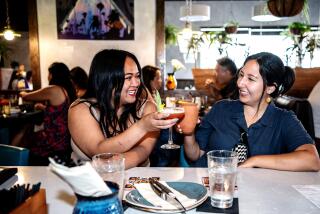Culinary Combat : State Community Colleges Go Dish to Dish to Cap 2-Year Hospitality Course
- Share via
SYLMAR — Early on in the fierce garnish competition, Jorge Perez and his teammates from Cerritos College looked like favorites.
Sure, other teams entered in the state’s first community college hospitality symposium, held Friday at Mission College, had turned radishes into blooming roses and pruned rough stalks of green onions and celery until they resembled delicate bonsai.
But no other team could boast that they carved the head of a falcon out of a block of Monterey jack cheese.
“It’s our school logo,” explained Perez, 23, installing a pair of black peppercorns for the falcon’s eyes.
“Time’s half up!” yelled a judge from the American Culinary Federation.
Perez’s three teammates didn’t even flinch--just kept cutting fruit. “It’s under control,” Perez said.
When it was all over, the Cerritos team had a stunning cheese plate and a magnificent fruit display. But they had completely forgotten the requisite vegetable platter, resulting in stiff penalties.
The garnish competition was just one part of the daylong symposium, the culmination of a two-year hospitality curriculum development program spearheaded by Mission and Glendale community colleges and funded by the state community college chancellor’s office.
Other events at the symposium included hot food competition, dining room table presentation, menu design and a knowledge bowl, won by Mission College, that included such questions as: “The yield grade of beef and lamb is based on the proportion of usable meat to water, fat or bone?” and “Name three kinds of lean saltwater fish.” (The answer to question one: fat. And two: halibut, striped bass and red snapper.)
But the most intense culinary combat was on the campus quad, where a kitchen, complete with stainless steel tables, ovens and stoves, was set up under canvass tents. There, an army of chefs-in-training from six different community colleges and the Los Angeles Culinary Institute in Encino labored furiously under strict deadlines.
Teams in the garnish competition had three hours to come up with buffet-style platters using a common stock of more than 30 kinds of raw produce and cheeses donated by the food industry.
Judges whispered together over clipboards, gauging overall presentation, harmony of colors and textures, appetite appeal, creativity, and the organization and kitchen skills of the competitors.
On the hot food side of the kitchen, temperatures were rising.
Team One, from Los Medanos College in Pittsburg, Calif., was running late by six minutes, and the senior judge, Master Chef Raimund Hofmeister of the Los Angeles Culinary Institute, wasn’t pleased.
“They lose two points for each minute they delay,” Hofmeister said. “That’s the name of the game.”
He took a seat at the judge’s table as the Los Medanos crew scrambled to dish out pasta and sauteed shrimp appetizers and carve the main course: underdone braised pork loin served with polenta and zucchini.
“I’d like it to be cooked another 20 minutes,” said Los Medanos’ Juan Coreas, with a sigh. “But it’s edible. We had oven problems.”
The ability to improvise and to overcome unforeseen obstacles is the mark of a truly good chef, said Sandra Lampert, coach of Mission College’s knowledge bowl team.
“This is art--culinary art,” Lampert said. “And the good thing is, if you make a mistake, you just eat it.”
More to Read
Eat your way across L.A.
Get our weekly Tasting Notes newsletter for reviews, news and more.
You may occasionally receive promotional content from the Los Angeles Times.










